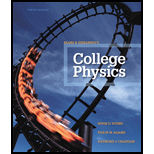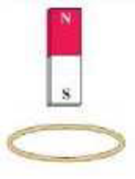
College Physics (10th Edition)
10th Edition
ISBN: 9780321902788
Author: Hugh D. Young, Philip W. Adams, Raymond Joseph Chastain
Publisher: PEARSON
expand_more
expand_more
format_list_bulleted
Textbook Question
Chapter 21, Problem 17P
A bar magnet is held above a circular loop of wire as shown in Figure 21.53. Find the direction (clockwise or counterclockwise, as viewed from below the loop) of the current induced in this loop in each of the following cases: (a) The loop is dropped, (b) The magnet is dropped, (c) Both the loop and magnet are dropped at the same instant.

Figure 21.53
Problem 17.
Expert Solution & Answer
Want to see the full answer?
Check out a sample textbook solution
Students have asked these similar questions
Deduce what overvoltage is like in reversible electrodes.
pls help on these
pls help on these
Chapter 21 Solutions
College Physics (10th Edition)
Ch. 21 - Prob. 1CQCh. 21 - Suppose you drop a cylindrical magnet down a long,...Ch. 21 - A long, straight current-carrying wire passes...Ch. 21 - Two closely wound circular coils have the same...Ch. 21 - Prob. 5CQCh. 21 - Why does a transformer not work with dc current?Ch. 21 - Does Lenzs law say that the induced current in a...Ch. 21 - Does Faradays law say that a large magnetic flux...Ch. 21 - An airplane is in level flight over Antarctica,...Ch. 21 - Prob. 10CQ
Ch. 21 - A metal ring can be moved into and out of the...Ch. 21 - Prob. 12CQCh. 21 - A square loop of wire is pulled upward out of the...Ch. 21 - The two solenoids in Figure 21.36 are coaxial and...Ch. 21 - A metal ring is oriented with the plane of its...Ch. 21 - Prob. 4MCPCh. 21 - A metal loop moves at constant velocity toward a...Ch. 21 - A steady current of 1.5 A flows through the...Ch. 21 - Suppose you continue to hold the current in the...Ch. 21 - A vertical bar moves horizontally at constant...Ch. 21 - The vertical loops A and C in Figure 21.41 e are...Ch. 21 - The vertical loops A and C in Figure 21.41 e are...Ch. 21 - After the switch S in the circuit in Figure 21.42...Ch. 21 - A metal loop is being pushed at a constant...Ch. 21 - A circular area with a radius of 6.50 cm lies in...Ch. 21 - Prob. 2PCh. 21 - An empty cylindrical food container with a lid on...Ch. 21 - A single loop of wire with an area of 0.0900 m2 is...Ch. 21 - A coil of wire with 200 circular turns of radius...Ch. 21 - In a physics laboratory experiment, a coil with...Ch. 21 - A closely wound rectangular coil of 80 turns has...Ch. 21 - Prob. 8PCh. 21 - Prob. 9PCh. 21 - A circular loop of wire a radius of 12.0 cm is...Ch. 21 - A cardboard tube is wrapped with windings of...Ch. 21 - A circular loop of wire is in a soalially uniform...Ch. 21 - Prob. 13PCh. 21 - A solenoid carrying a current i is moving toward a...Ch. 21 - A metal bar is pulled to the right perpendicular...Ch. 21 - Two closed loops A and C are close to a long wire...Ch. 21 - A bar magnet is held above a circular loop of wire...Ch. 21 - The current in Figure 21.54 obeys the equation I =...Ch. 21 - A bar magnet is close to a metal loop. When this...Ch. 21 - A very thin 15.0 cm copper bar is aligned...Ch. 21 - When a thin 12.0 cm iron rod moves with a constant...Ch. 21 - You wish to produce a potential difference of 10 V...Ch. 21 - A 1.41 m bar moves through a uniform, 1.20 T...Ch. 21 - The conducting rod ab shown in Figure 21.58 makes...Ch. 21 - BO Measuring blood flow. Blood contains positive...Ch. 21 - Prob. 26PCh. 21 - Prob. 27PCh. 21 - Prob. 28PCh. 21 - Prob. 29PCh. 21 - Prob. 30PCh. 21 - Prob. 31PCh. 21 - Prob. 32PCh. 21 - Prob. 33PCh. 21 - Prob. 34PCh. 21 - Prob. 35PCh. 21 - A transformer consists of 275 primary windings and...Ch. 21 - You need a transformer that will draw 15 W of...Ch. 21 - A step-up transformer. A transformer connected to...Ch. 21 - Prob. 39PCh. 21 - Prob. 40PCh. 21 - Prob. 41PCh. 21 - A solenoid 25.0 cm long and with a cross-sectional...Ch. 21 - Prob. 43PCh. 21 - Prob. 44PCh. 21 - Prob. 45PCh. 21 - Prob. 46PCh. 21 - Prob. 47PCh. 21 - Prob. 48PCh. 21 - Prob. 49PCh. 21 - A 12.0 F capacitor and a 5.25 mH inductor are...Ch. 21 - Prob. 51PCh. 21 - A 15.0 F capacitor is charged to 175 C and then...Ch. 21 - Prob. 53GPCh. 21 - A rectangular circuit is moved at a constant...Ch. 21 - Prob. 55GPCh. 21 - A flexible circular loop 6.50 cm in diameter lies...Ch. 21 - Prob. 57GPCh. 21 - Prob. 58GPCh. 21 - Consider the circuit in Figure 21.64 (a) Just...Ch. 21 - How many turns does this typical MRI magnet have?...Ch. 21 - BIO Quenching an MRI magnet. Magnets carrying very...Ch. 21 - If part of the magnet develops resistance and...Ch. 21 - BIO Quenching an MRI magnet. Magnets carrying very...Ch. 21 - Prob. 64PPCh. 21 - Consider the brain tissue at the level of the...Ch. 21 - Prob. 66PPCh. 21 - Which graph best represents the time t dependence...
Additional Science Textbook Solutions
Find more solutions based on key concepts
Your bore cells, muscle cells, and skin cells look different because a. different kinds of genes are present in...
Campbell Essential Biology (7th Edition)
1.1 Write a one-sentence definition for each of the following:
a. chemistry
b. chemical
Chemistry: An Introduction to General, Organic, and Biological Chemistry (13th Edition)
In the light reactions, what is the initial electron donor? Where do the electrons finally end up?
Campbell Biology (11th Edition)
Choose the best answer to each of the following. Explain your reasoning. If there is going be a total lunar ecl...
Cosmic Perspective Fundamentals
What name is given to the zone of greatest seismic activity?
Applications and Investigations in Earth Science (9th Edition)
Q1. Which wavelength of light has the highest frequency?
a) 10 nm
b) 10 mm
c) 1 nm
d) 1 mm
Chemistry: A Molecular Approach (4th Edition)
Knowledge Booster
Learn more about
Need a deep-dive on the concept behind this application? Look no further. Learn more about this topic, physics and related others by exploring similar questions and additional content below.Similar questions
- 20. Two small conducting spheres are placed on top of insulating pads. The 3.7 × 10-10 C sphere is fixed whie the 3.0 × 107 C sphere, initially at rest, is free to move. The mass of each sphere is 0.09 kg. If the spheres are initially 0.10 m apart, how fast will the sphere be moving when they are 1.5 m apart?arrow_forwardpls help on allarrow_forwardpls help on thesearrow_forward
- pls help on all asked questions kindlyarrow_forwardpls help on all asked questions kindlyarrow_forward19. Mount Everest, Earth's highest mountain above sea level, has a peak of 8849 m above sea level. Assume that sea level defines the height of Earth's surface. (re = 6.38 × 106 m, ME = 5.98 × 1024 kg, G = 6.67 × 10 -11 Nm²/kg²) a. Calculate the strength of Earth's gravitational field at a point at the peak of Mount Everest. b. What is the ratio of the strength of Earth's gravitational field at a point 644416m below the surface of the Earth to a point at the top of Mount Everest? C. A tourist watching the sunrise on top of Mount Everest observes a satellite orbiting Earth at an altitude 3580 km above his position. Determine the speed of the satellite.arrow_forward
- pls help on allarrow_forwardpls help on allarrow_forward6. As the distance between two charges decreases, the magnitude of the electric potential energy of the two-charge system: a) Always increases b) Always decreases c) Increases if the charges have the same sign, decreases if they have the opposite signs d) Increases if the charges have the opposite sign, decreases if they have the same sign 7. To analyze the motion of an elastic collision between two charged particles we use conservation of & a) Energy, Velocity b) Momentum, Force c) Mass, Momentum d) Energy, Momentum e) Kinetic Energy, Potential Energyarrow_forward
- pls help on all asked questions kindlyarrow_forwardpls help on all asked questions kindlyarrow_forward17. Two charges, one of charge +2.5 × 10-5 C and the other of charge +3.7 × 10-6 C, are 25.0 cm apart. The +2.5 × 10−5 C charge is to the left of the +3.7 × 10−6 C charge. a. Draw a diagram showing the point charges and label a point Y that is 20.0 cm to the left of the +3.7 × 10-6 C charge, on the line connecting the charges. (Field lines do not need to be drawn.) b. Calculate the net electric field at point Y.arrow_forward
arrow_back_ios
SEE MORE QUESTIONS
arrow_forward_ios
Recommended textbooks for you
 Physics for Scientists and Engineers: Foundations...PhysicsISBN:9781133939146Author:Katz, Debora M.Publisher:Cengage Learning
Physics for Scientists and Engineers: Foundations...PhysicsISBN:9781133939146Author:Katz, Debora M.Publisher:Cengage Learning Principles of Physics: A Calculus-Based TextPhysicsISBN:9781133104261Author:Raymond A. Serway, John W. JewettPublisher:Cengage Learning
Principles of Physics: A Calculus-Based TextPhysicsISBN:9781133104261Author:Raymond A. Serway, John W. JewettPublisher:Cengage Learning
 Physics for Scientists and Engineers, Technology ...PhysicsISBN:9781305116399Author:Raymond A. Serway, John W. JewettPublisher:Cengage Learning
Physics for Scientists and Engineers, Technology ...PhysicsISBN:9781305116399Author:Raymond A. Serway, John W. JewettPublisher:Cengage Learning Physics for Scientists and EngineersPhysicsISBN:9781337553278Author:Raymond A. Serway, John W. JewettPublisher:Cengage Learning
Physics for Scientists and EngineersPhysicsISBN:9781337553278Author:Raymond A. Serway, John W. JewettPublisher:Cengage Learning Physics for Scientists and Engineers with Modern ...PhysicsISBN:9781337553292Author:Raymond A. Serway, John W. JewettPublisher:Cengage Learning
Physics for Scientists and Engineers with Modern ...PhysicsISBN:9781337553292Author:Raymond A. Serway, John W. JewettPublisher:Cengage Learning

Physics for Scientists and Engineers: Foundations...
Physics
ISBN:9781133939146
Author:Katz, Debora M.
Publisher:Cengage Learning

Principles of Physics: A Calculus-Based Text
Physics
ISBN:9781133104261
Author:Raymond A. Serway, John W. Jewett
Publisher:Cengage Learning


Physics for Scientists and Engineers, Technology ...
Physics
ISBN:9781305116399
Author:Raymond A. Serway, John W. Jewett
Publisher:Cengage Learning

Physics for Scientists and Engineers
Physics
ISBN:9781337553278
Author:Raymond A. Serway, John W. Jewett
Publisher:Cengage Learning

Physics for Scientists and Engineers with Modern ...
Physics
ISBN:9781337553292
Author:Raymond A. Serway, John W. Jewett
Publisher:Cengage Learning
What is Electromagnetic Induction? | Faraday's Laws and Lenz Law | iKen | iKen Edu | iKen App; Author: Iken Edu;https://www.youtube.com/watch?v=3HyORmBip-w;License: Standard YouTube License, CC-BY